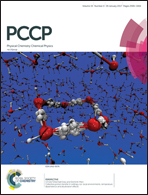Radical recombination in interstellar ices, a not so simple mechanism
Abstract
Many complex organic molecules (hereafter COMs) have been detected in different regions of the interstellar medium (ISM). In each region, different energetic processes – UV irradiation, atom bombardments, etc. – that could be linked to the formation of detected COMs may occur depending on the environment. Several formation mechanisms were proposed but increasing attention is paid to radical recombination reactions. Previous studies showed that glycolaldehyde (HC(O)CH2OH) and ethylene glycol (HOCH2CH2OH) are formed by radical recombination between HC˙O and ˙CH2OH, and by ˙CH2OH dimerisation, respectively. Formyl (HC˙O), one of the most famous astrophysically-relevant radical species, has been detected as a gaseous component of the ISM. Its reactivity was already attributed to the formation of several COMs. This work aims to study the dimerisation of formyl radical HC˙O using a cryogenic matrix technique. The evolution of the chemical sample composition is monitored by infrared spectroscopy and by mass spectrometry during temperature programmed desorption (TPD) monitoring. Results indicate that the reaction of one HC˙O with another does not lead to the direct formation of glyoxal (HC(O)C(O)H) but yields H2CO and CO. Results are also compared with those for the reaction between two ˙CH2OH radicals and the recombination between HC˙O and ˙CH2OH. Also, glyceraldehyde was tentatively detected in our experiment using different spectroscopic techniques. A radical mechanism is proposed to explain its formation in our experiments. Complementary quantum chemical calculations provide an atomistic interpretation of the experimental findings.


 Please wait while we load your content...
Please wait while we load your content...